
Sawflies are the insects of the suborder Symphyta within the order Hymenoptera alongside ants, bees and wasps. The common name comes from the saw-like appearance of the ovipositor, which the females use to cut into the plants where they lay their eggs. The name is associated especially with the Tenthredinoidea, by far the largest superfamily in the suborder, with about 7,000 known species; in the entire suborder, there are 8,000 described species in more than 800 genera. Symphyta is paraphyletic, consisting of several basal groups within the order Hymenoptera, each one rooted inside the previous group, ending with the Apocrita which are not sawflies.
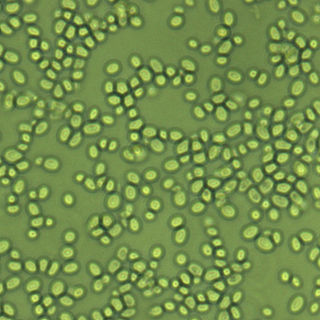
Candida glabrata is a species of haploid yeast of the genus Candida, previously known as Torulopsis glabrata. Despite the fact that no sexual life cycle has been documented for this species, C. glabrata strains of both mating types are commonly found. C. glabrata is generally a commensal of human mucosal tissues, but in today's era of wider human immunodeficiency from various causes, C. glabrata is often the second or third most common cause of candidiasis as an opportunistic pathogen. Infections caused by C. glabrata can affect the urogenital tract or even cause systemic infections by entrance of the fungal cells in the bloodstream (Candidemia), especially prevalent in immunocompromised patients.
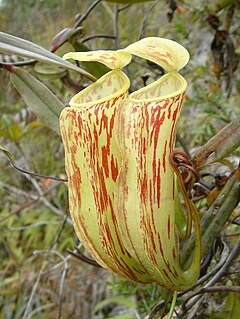
Nepenthes glabrata is a tropical pitcher plant endemic to Sulawesi. The species grows in open, high forest at elevations of 1600 to 2100 m. It produces dainty, colourful pitchers reaching only a few centimetres in height. These traps are red speckled on a yellowish background, giving them a "hand painted" appearance.

Tenthredinidae is the largest family of sawflies, with well over 7,500 species worldwide, divided into 430 genera. Larvae are herbivores and typically feed on the foliage of trees and shrubs, with occasional exceptions that are leaf miners, stem borers, or gall makers. The larvae of externally feeding species resemble small caterpillars. As with all hymenopterans, common sawflies undergo complete metamorphosis.
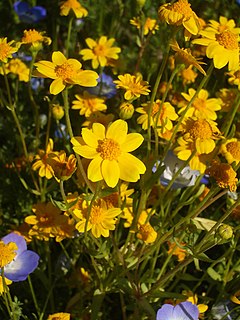
Lasthenia glabrata is a North American species of flowering plant in the daisy family known by the common names yellowray goldfields and yellow-rayed lasthenia. It is endemic to California, where it is a resident of vernal pools and other moist areas in a number of habitat types. It is widespread across much of the state, from San Diego County to Tehama County.

Fenusa dohrnii, the European alder leafminer, is a species of common sawfly in the family Tenthredinidae. It is found in Europe.
Fenusa is a genus of common sawflies in the family Tenthredinidae. There are about 11 described species in Fenusa.
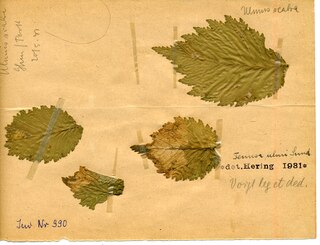
Fenusa ulmi, the elm leafminer, is a species of common sawfly in the family Tenthredinidae. It is found in Europe.
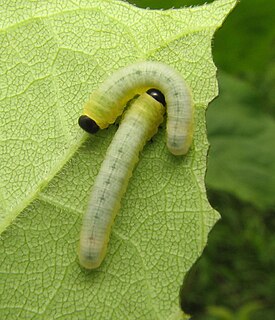
Tethida is a genus of common sawflies in the family Tenthredinidae. There is one described species in Tethida, T. barda.
Janus integer, the currant stem girdler, is a species of stem sawfly in the family Cephidae.
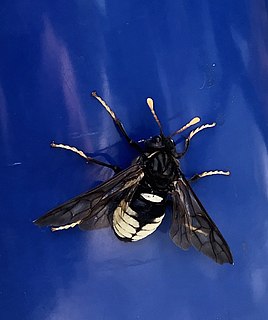
Cimbex americana, the elm sawfly, is a species of sawfly in the family Cimbicidae. This is a very large species of Hymenoptera, with adults measuring 3 cm and larvae reaching 5 cm long. If captured, adults may buzz and use their powerful spiny legs defensively. However, like other sawflies, this species does not possess a sting.
Ametastegia pallipes, the violet sawfly, is a species of common sawfly in the family Tenthredinidae. It is found in Europe.

Ametastegia is a genus of common sawflies in the family Tenthredinidae. There are about 16 described species in Ametastegia.
Pachynematus extensicornis, the grass sawfly, is a species of common sawfly in the family Tenthredinidae.
Nematus ventralis, the willow sawfly, is a species of common sawfly in the family Tenthredinidae.
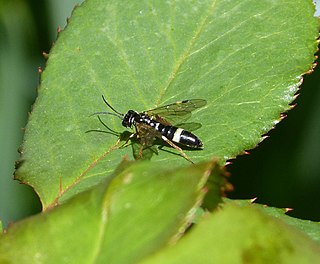
Allantus cinctus, known generally as the curled rose sawfly or banded rose sawfly, is a species of common sawfly in the family Tenthredinidae. It is found in Europe.

Schizocerella is a genus of sawflies in the family Argidae. There are at least two described species in Schizocerella.

Sphacophilus cellularis is a species of sawfly in the family Argidae.

Sphacophilus is a genus of sawflies in the family Argidae. There are more than 30 described species in Sphacophilus.

Pristiphora geniculata, the mountain ash sawfly, is a species of common sawfly in the family Tenthredinidae. It is found in Europe.















